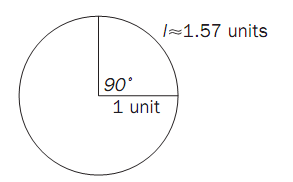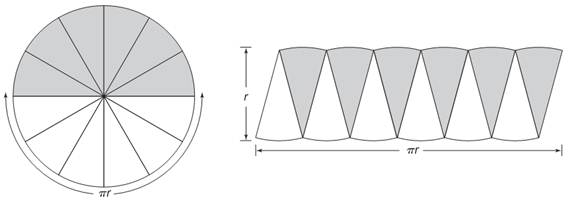


 تاريخ الرياضيات
تاريخ الرياضيات
 الرياضيات في الحضارات المختلفة
الرياضيات في الحضارات المختلفة 
 الرياضيات المتقطعة
الرياضيات المتقطعة
 الجبر
الجبر
 الهندسة
الهندسة 
 المعادلات التفاضلية و التكاملية
المعادلات التفاضلية و التكاملية 
 التحليل
التحليل
 علماء الرياضيات
علماء الرياضيات |
Read More
Date: 7-1-2016
Date: 5-1-2016
Date: 11-1-2016
|
The measurement of circles is closely connected to the measurement of angles. This is because the measurement has a rotational aspect; that is, one ray must be turned about the vertex until it coincides with a more static aspect. The circle is the perfect tool for measuring planes of angles, because any angle cuts off the same fractional part of every circle whose center is at the vertex of the angle.
Different Ways to Measure Circles
In degree measure, the circle is divided into 360 equal parts, while in gradient measure, 400 equal parts of a circle are used. Since there are four right angles in a circle, there are 100 gradients in a right angle, making gradients a better fit with the decimal system. Nevertheless, degree measure is the predominant system for measuring angles using fractional parts of a circle.
A different method for measuring angles based on a circle is radian measure. The importance of radian measure is that numerous results in calculus involving trigonometric functions—for example, sine, cosine, or tangent—require that the angle of the trigonometric function be measured in radians.
Using Radian Measure.
To understand radian measure, it is necessary to understand that rather than using the fractional part of a circle cut off by the angle, the fractional part is converted to a distance. The portion of a circle cut off by an angle with its vertex at the center of the circle is called an arc of the circle. The distance used to measure an angle in radian measure is the length of that arc.

The first question is which circle to use. When using fractional parts of a circle, the particular circle used does not matter. However, when using arc length, the same angle cuts off a longer arc on larger circles than on smaller circles. So, when using arc length to measure an angle, the particular circle used does matter.
In order to simplify calculations, a circle with a radius of 1 unit is chosen. Then the conversion from fractional part of a circle to the length of arc follows from proportional reasoning. The ratio of the arc to the whole circle—that is, the fractional part of the circle—must be the same as the ratio of the length of the arc to the length, or circumference, of the whole circle. In symbols, if the number of degrees in the arc is x, the length of the arc is l, and the circumference of the circle is C, you can write: x°/360° = l/C.

The second question is how to determine the circumference, C. The ratio of the circumference of a circle to the length of its diameter, d, is defined to be π; that is, C/d= π. Multiplying both sides of this equation by d yieldsa formula: C = πd. Now since d =2r, the previous formula can be rewritten as C= π.2r = 2πr. Finally, if r =1, then C =2πr = 2π.1= 2π. Substituting this expression for C in the first ratio above, you get x° /360° =l/2π, andmultiplying both sides of this equation by 2π gives l = x /360. 2π for the length of the arc cut off by an angle of x° on a circle with a radius of 1 unit.
Using the last equation gives some equivalents. For example, if x = 360°,then l= 360/360.2π= 2π. Therefore, 360° =2π radians. Similarly, if x = 180°, l = 180/360.2π = 1/2 . 2π = π. This gives a basic conversion factor:180° = π radians. An angle of one radian has the same measure as the central angle in a circle whose arc is the length of the radius. One radian isabout 57° 1745.
Other common equivalents which can be derived from the previous equation are: 90°= π/2 radians, 60° = π/3 radians, 45° = π/4 radians, and 30° = π/6 radians. In all of these conversions it is important to understand just what the radian measure means. For example, as shown below, to say that a 90°angle is equal to π/2 radians is the same as saying that, on a circle having a radius of 1 unit, a 90° angle with its vertex as the center of the circle cuts off an arc that is π2 ≈1.57 units long, and so forth.

Historic Methods of Measuring Circles
Early tools for drawing circles almost certainly included attaching a drawing instrument to a length of cord, stretching the cord to the desired radius, holding the cord in place at the desired center, and swinging the drawing instrument in a circular path. However, by the time of Euclid (about 300 B.C.E.) a tool similar to the modern compasses, or dividers, was in use.
However, the pair of compasses Euclid envisioned had an important difference from those in use today. Euclid used only collapsible compasses; that is, as soon as one point of the compasses was lifted from the paper, they closed. This prevented using the compasses as a set of dividers to transfer distances directly from one place to another in a geometric construction.
The term “collapsible compasses” refers not to the fact that the tool would close when lifted from the paper, but rather to the rule of construction imposed by the ancient Greek mathematicians that the tool was not to be used to transfer distances after being lifted from the paper. Interestingly, later mathematicians used some of Euclid’s postulates and theorems to prove that his “collapsible compasses” are equivalent to the modern compasses.
Circumference is a measure of the boundary of a circle. An equally important property is the area of a circle, which is a measure of the interior of the circle. In the third century B.C.E., Archimedes proved that the area of a circle is equal to the area of a right triangle whose legs are equal in length to the radius and the circumference of the circle. That is, since the area of a triangle is one-half the product of a base and the altitude to that base, and since in a right triangle, if one leg is used as the base, the other leg is the altitude to that base, Archimedes proved that the area of a circle is given by the formula A = 1/2 r (2πr) = πr2.

It is difficult to know for certain what motivated this idea for Archimedes, but the diagram below shows one possibility. Notice that when a circle is cut into an even number of equal-sized sectors, or wedge shapes, these sectors can be rearranged to form a figure that is approximately a parallelogram.
The length of the altitude of the approximated parallelogram would then be the same as the radius of the circle, and the length of the base of the parallelogram would be one-half the circumference of the circle. Then, the area of a parallelogram is the product of the lengths of its base and altitude, yielding the same formula for the area:


Squaring the Circle.
One of the classic problems of ancient mathematics was the problem of finding a square exactly equal in area to a given circle.
This problem has come to be known as the problem of “squaring the circle.” The ancient Egyptians had such a procedure. They merely took eightninths of the square of the diameter, a formula that is equivilant to taking π≈3.16, but it is unclear whether they realized that this was just an approximation to the area of the circle.
The ancient Greek mathematicians spent much time and energy in seeking a solution to the problem of squaring the circle. They refined the problem by placing the restriction that the required square could be found by use of compasses and straight-edge only. A number of Greek mathematicians were able to produce constructions of squares whose areas exactly equaled a given circle, but none was able to do so under the restriction of compasses and straight-edge alone. However, in producing their solutions (which they knew full well did not satisfy the restriction), these ancient Greek mathematicians developed new and profound mathematics.
The problem of squaring the circle by means of compasses and straightedge alone continued to intrigue mathematicians through the nineteenth century. Finally, in 1882, Ferdinand Lindemann put the age-old question to rest by proving that π is a special kind of real number called a transcendental. None of the transcendental numbers can be constructed using only a straight-edge and compass. In other words, it is impossible to find a square exactly equal in area to a given circle using only these tools.
______________________________________________________________________________________________
Reference
Banchoff, Thomas F. “Dimension.” On the Shoulders of Giants: New Approaches to Numeracy ed. Lynne Arthur Steen. Washington: National Academy of Press, 1990.
Ball, W. W. Rouse. A Short Account of the History of Mathematics. New York: Dover, 1960.
Boyer, Carl B., revised by Uta C. Merzbach. A History of Mathematics, 2nd ed. New York: John Wiley & Sons, 1991.
Coxford, Arthur, Zalman Usiskin, and Daniel Hirschhorn. Geometry. Glenview, IL: Scott Foresman, 1991.
National Council of Teachers of Mathematics. Historical Topics for the Mathematics Classroom, Thirty-first Yearbook. Washington: The Council, 1969.
Smith, David Eugene. History of Mathematics, Vol. 1 & 2. Boston: Ginn & Co., 1923.



|
|
|
|
تفوقت في الاختبار على الجميع.. فاكهة "خارقة" في عالم التغذية
|
|
|
|
|
|
|
أمين عام أوبك: النفط الخام والغاز الطبيعي "هبة من الله"
|
|
|
|
|
|
|
المجمع العلمي ينظّم ندوة حوارية حول مفهوم العولمة الرقمية في بابل
|
|
|